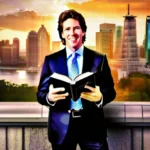Explore the life, teachings, controversies, and rise of Joel Osteen, one of the most famous megachurch pastors in the world.
Joel Osteen is a renowned pastor, televangelist, and author who leads one of the largest megachurches in the world. This article uncovers his rise to fame, the heart of his teachings, and the controversies that have followed him.
Who is Joel Osteen?
Who exactly is Joel Osteen, and why does his name spark such strong reactions from both fans and critics? To some, he’s a beacon of hope, a symbol of unwavering positivity in a world filled with doubt. To others, he’s a controversial figure at the center of debates on wealth, faith, and the true meaning of Christianity. But love him or question him, there’s no denying that Joel Osteen is one of the most recognized figures in modern Christian ministry.
At the heart of Osteen’s story is Lakewood Church, a spiritual powerhouse that draws over 50,000 attendees every week and millions more via live streams and television broadcasts. But it’s not just the size of the crowd that stands out — it’s the atmosphere. People don’t just attend a service; they experience it. With larger-than-life screens, dazzling stage lights, and music performances that rival world-class concerts, Lakewood Church feels more like an arena spectacle than a traditional house of worship. But isn’t that the point? Osteen understands that people are looking for an experience, a moment of clarity where hope replaces doubt and faith feels tangible. He delivers exactly that.
Unlike many pastors who rise through theological study and formal training, Joel Osteen took an unconventional path. He wasn’t always front and center. For years, he worked behind the scenes producing his father John Osteen’s television broadcasts. It was only after his father’s sudden passing that he stepped into the role of senior pastor. It’s a classic “reluctant hero” story, where the unassuming figure steps into greatness. And step into greatness he did. Under his leadership, Lakewood grew from a humble church to a global faith empire.
But what makes Joel Osteen stand out from the thousands of other preachers out there? It’s his message. While many focus on sin, suffering, and redemption, Osteen takes a different route. His message isn’t about guilt; it’s about growth. He preaches a “you can do it” gospel, a message of empowerment, self-belief, and divine favor. In a world where bad news dominates headlines, his message of optimism cuts through the noise. It’s no wonder people cling to his words — he offers what so many are desperate for: hope.
Yet, Osteen is not just a preacher — he’s a brand. His face is on book covers, TV screens, YouTube thumbnails, and social media feeds. His influence extends far beyond the walls of Lakewood Church. For his followers, his teachings are a lifeline; for critics, they are fuel for fiery debates. But perhaps that’s part of the allure. Joel Osteen is not a man you ignore. He’s a figure you either follow or challenge, and that’s exactly why his name is still on everyone’s lips.
Early Life and Path to Ministry
Joel Osteen’s journey to becoming one of the most influential televangelists in the world wasn’t one marked by prophecy or divine visions — it was rooted in family legacy, quiet diligence, and an unexpected twist of fate. His story is a testament to how the path we think we’re on can shift in an instant.
Born on March 5, 1963, in Houston, Texas, Joel was one of six children in a household where faith wasn’t just a belief — it was a lifestyle. His father, John Osteen, was already a towering figure in the world of Christian ministry. As the founder of Lakewood Church, John Osteen was a fiery preacher, a man known for his passionate delivery and unwavering devotion. From the outside looking in, it might seem that Joel was destined to follow in his father’s footsteps. But destiny had other ideas.
While many might expect the son of a pastor to step right into the pulpit, Joel’s path was far from direct. He had no grand dreams of preaching to thousands. In fact, he actively avoided it. Instead, he focused on the technical side of the ministry, producing his father’s television broadcasts. For 17 years, he stayed behind the camera, ensuring every frame, soundbite, and broadcast met the high standards of Lakewood’s growing media presence. If faith is a stage, Joel was perfectly content working the lights and sound.
But fate, as it often does, had a different script. In 1999, John Osteen passed away unexpectedly from a heart attack. Suddenly, the son who had never preached a sermon was thrust into the role of senior pastor. Imagine the weight of that moment. Thousands of eyes looking to you, expecting you to carry the legacy of a man who had spent decades building one of the most beloved churches in the country. Could he fill those shoes? Did he even want to? These questions lingered, but Joel didn’t have time to ponder them for long. Sometimes, destiny doesn’t knock — it barges in.
With nervous energy and faith as his only safety net, Joel stepped up to the pulpit. His first sermon wasn’t polished, but it didn’t have to be. What he lacked in theological expertise, he made up for in authenticity and heart. People didn’t just listen — they leaned in. There was something different about his delivery. He didn’t thunder down judgment from the pulpit. Instead, he spoke like a friend encouraging you over a cup of coffee. People could relate. They didn’t just hear his words; they felt them.
What happened next was nothing short of extraordinary. In just a few years, Lakewood Church grew beyond anyone’s expectations. Joel’s fresh approach to ministry, blending optimism with spirituality, struck a chord. He wasn’t preaching fire and brimstone — he was offering hope and possibility. And isn’t that what people were searching for?
Joel Osteen’s rise to the pulpit wasn’t planned, but perhaps that’s the most profound part of the story. It’s proof that you don’t have to have all the answers before you begin. Sometimes, life calls you to step forward, ready or not. And in Joel’s case, he answered that call with unwavering faith and a belief that he was exactly where he was supposed to be.
Rise of Lakewood Church and Global Fame
How does a modest church tucked away in the heart of Houston, Texas, transform into a global faith empire? The answer lies in the story of Lakewood Church, a place that went from filling pews to filling stadiums — literally. Under Joel Osteen’s leadership, Lakewood didn’t just grow; it exploded, becoming the largest megachurch in the United States and one of the most influential religious institutions in the world.
When Joel Osteen took the helm as senior pastor in 1999, few could have predicted what was about to happen. Lakewood Church was already a well-known local ministry thanks to the legacy of his father, John Osteen, but it was nowhere near the cultural phenomenon it would soon become. Joel had a vision that was as ambitious as it was bold: to bring his father’s message of hope and faith to a global audience. But how do you go from a local congregation to a worldwide movement?
The answer can be summed up in one word: scale. Joel’s first major move was nothing short of monumental. In 2003, Lakewood Church purchased the Compaq Center — yes, the same arena that was once home to the Houston Rockets NBA team. This wasn’t just a symbolic move; it was a declaration. No longer confined to the four walls of a traditional church, Lakewood now had the capacity to welcome over 16,000 attendees every week. Picture it: thousands of people filling seats like a sold-out concert, hands raised, singing along to worship music. This wasn’t just a church service; it was a spiritual experience on a grand scale.
But Joel didn’t stop there. Recognizing the power of media, he expanded Lakewood’s reach beyond Houston’s city limits. Television broadcasts of his sermons began airing weekly, not just in the United States, but around the world. Suddenly, a family in Kenya or a viewer in Brazil could tune in and hear the same message of positivity, hope, and faith. This wasn’t just luck — it was strategy. Osteen embraced technology in a way that many traditional ministries had not, and it paid off. His broadcasts reached millions, and his online presence grew exponentially with every new platform that emerged.
What makes Lakewood’s rise so extraordinary is that it wasn’t built on spectacle alone. People weren’t just showing up for the lights, the sound, or the grandeur of the Compaq Center. They were showing up for Joel’s message — a message that promised them something better. His sermons became weekly reminders that “your breakthrough is on the way” and that “you are closer than you think” to achieving your dreams. In a world filled with cynicism, Osteen’s words felt like fresh air. He wasn’t telling people what they had done wrong; he was telling them what they could do right.
Of course, not everyone was sold on the idea. Critics claimed the “mega” aspect of this megachurch was too flashy, too commercialized, and too focused on material success. But for every critic, there were ten more followers drawn to the message of possibility and potential. The numbers don’t lie. Each week, more than 50,000 people physically attend Lakewood’s services, while millions more watch online or on television.
Lakewood Church’s rise is more than just a story about a building or a preacher. It’s a case study in transformation. It’s a reminder that, with vision, faith, and the willingness to take risks, something small can become something monumental. What started as a neighborhood ministry now stands as a beacon of hope for millions worldwide, and it shows no signs of slowing down.
Teachings and The Power of Positivity
If there’s one thing Joel Osteen is known for, it’s his message of positivity. But what does “positivity” actually mean in the context of faith? For Osteen, it’s more than just feel-good motivation — it’s a spiritual strategy. While many pastors focus on sin, repentance, and moral correction, Osteen flips the script. His sermons aren’t rooted in fear; they’re rooted in possibility. It’s a radical shift from the traditional fire-and-brimstone approach of many churches, and it’s one of the key reasons his message resonates with millions.
At the heart of Osteen’s teachings is the idea of “speaking victory into existence.” Sound like wishful thinking? Maybe — but for Osteen, it’s rooted in biblical principles. He often references Proverbs 18:21: “The tongue has the power of life and death.” His sermons remind followers that their words have power. Instead of saying, “I’ll never get that promotion,” Osteen encourages his listeners to declare, “The right opportunities are coming my way.” It’s more than positive thinking — it’s faith in action.
This approach is often tied to what some call “prosperity theology” — the belief that faith, positive words, and donations can lead to financial success. Critics call it shallow; followers call it inspiring. But regardless of which side you’re on, it’s hard to deny that it works. For many people, Osteen’s words are like a life raft in a sea of doubt. His message gives them permission to believe that better days are ahead. And in a world where stress and anxiety seem to grow by the day, isn’t that exactly what people are searching for?
Osteen also emphasizes the power of self-worth. His sermons remind people that they are “children of God” and that, as such, they deserve happiness, peace, and success. This message of inherent worth is a sharp contrast to religious teachings that emphasize guilt or unworthiness. It’s a message of empowerment — and that’s why so many listeners feel uplifted after a sermon. Instead of being told they need to “do better” or “fix themselves,” Osteen tells them, “You are already worthy of God’s blessings.”
What makes his message even more compelling is how personal it feels. Osteen doesn’t preach as if he’s better than his listeners. He shares stories about his own challenges, mistakes, and moments of doubt. This relatability is part of his charm. His audience doesn’t see him as an untouchable religious figure; they see him as someone walking the same path they are — just a little further ahead.
But perhaps the most striking part of Osteen’s teachings is his belief in divine timing. He reminds people that “delays are not denials.” If your dream hasn’t come to pass, it’s not because God has forgotten you — it’s because the timing isn’t right. For people struggling with disappointment, this message feels like a lifeline. It tells them to keep believing, keep pushing, and stay patient, because the breakthrough is on its way.
While critics may argue that Osteen’s approach is too “feel-good” or that it downplays the hardships of life, his followers tell a different story. For them, his message is transformative. It’s not about ignoring life’s struggles — it’s about facing them with unshakable confidence. To his critics, he’s selling hope. To his followers, he’s offering something far more valuable — a reason to keep going when everything else says stop. And in a world that often feels bleak, that message is priceless.
Controversies and Public Backlash
No one rises to fame without stirring up a little controversy, and Joel Osteen is no exception. For every admirer who sees him as a symbol of hope, there’s a critic ready to call him a “prosperity preacher” chasing fame and fortune. But what exactly fuels these controversies, and why does his name spark such intense reactions?
One of the most publicized moments of backlash came during Hurricane Harvey in 2017. As the floodwaters rose in Houston, so did public outrage. Images circulated online showing Lakewood Church’s massive building dry and intact, yet its doors were reportedly closed to evacuees. Critics flooded social media, asking, “How can the largest church in Houston stay locked during a crisis?” It didn’t take long for Osteen’s name to trend — but for all the wrong reasons. People accused him of prioritizing wealth and image over compassion. Under mounting pressure, the church eventually opened its doors as a shelter, but by then, the damage had been done. Osteen defended his actions, claiming the church itself had been impacted by flooding and wasn’t immediately safe for evacuees. But once public perception turns, it’s hard to turn it back.
Then there’s the “prosperity gospel” debate, which has followed Osteen for most of his career. While his message of positivity draws millions, critics argue that he preaches wealth instead of worship. They point to his luxurious lifestyle — a multi-million-dollar mansion, luxury cars, and designer clothes — as evidence that he’s cashing in on the faith of his followers. Osteen, however, has repeatedly stated that he draws no salary from Lakewood Church, with his income coming from book sales and speaking engagements. But for critics, that’s not enough. The image of a pastor living in a mansion while encouraging followers to “sow a seed” for their breakthrough is an easy target for backlash. To his supporters, he’s proof that blessings follow faith. To his critics, he’s a walking contradiction.
Another frequent point of contention is his “soft theology.” Unlike traditional pastors who preach about sin, repentance, and the trials of following a righteous path, Osteen emphasizes personal growth, happiness, and the promise of a better life. Critics argue that his feel-good message ignores the harsher realities of Christian doctrine. Where’s the call for repentance? Where’s the challenge to confront sin? Osteen’s response? He says his goal is to “lift people up, not weigh them down.” He’s not interested in focusing on what’s wrong with people; he’d rather help them see what’s right. To some, that’s a breath of fresh air. To others, it’s theology without teeth.
And, of course, there’s the ever-present issue of wealth in ministry. Osteen’s net worth is reported to be in the tens of millions, and his wealth has become a flashpoint in debates about televangelists and their financial transparency. Should a pastor live like a celebrity? Should donations from faithful followers help fund mansions, vacations, and luxury lifestyles? The argument isn’t new, but Osteen remains one of its most prominent faces. His defense is simple: “I’m blessed because I’m faithful.” To his audience, that explanation is more than enough. To his detractors, it’s another example of how modern ministry has lost its way.
For all the criticism, one thing is clear: Joel Osteen is not going anywhere. Controversy may cast a shadow, but for Osteen, it’s just part of living in the spotlight. And, as his critics have learned, it’s hard to dim a light that so many people still look toward for guidance.
Books, Media Influence and Wealth
Joel Osteen isn’t just a pastor — he’s a brand. While many preachers confine their influence to the pulpit, Osteen took his message beyond the church walls and into living rooms, bookstores, and social media feeds around the world. His books, media presence, and financial success have become a hallmark of his career, sparking admiration from some and criticism from others. But how did he turn his message of faith into a media empire?
It all started with his breakout book, “Your Best Life Now.” Published in 2004, the book became an instant bestseller, landing on the New York Times Best Seller list and staying there for weeks. Its central message was simple yet profound: “Live in the present, speak positively, and believe in God’s plan for your life.” Readers couldn’t get enough. The book wasn’t a dense theological study — it was a practical guide filled with affirmations, personal stories, and steps toward personal growth. This approachable style made it accessible to millions, even those who had never set foot in a church. People who had never heard of Joel Osteen before suddenly found themselves highlighting his words, writing them on sticky notes, and using his affirmations as daily reminders.
The success of “Your Best Life Now” wasn’t a fluke. Osteen followed it up with more bestsellers, including “Become a Better You” and “Every Day a Friday.” Each book sold millions of copies and reinforced his image as not just a preacher but a self-help guru with a Christian twist. These books weren’t just sold in religious stores; they were front-and-center in mainstream retailers like Walmart, Target, and Barnes & Noble. The message was clear: Osteen’s appeal wasn’t limited to churchgoers — it was universal.
But Osteen’s influence didn’t stop at the bookstore. Television was his next frontier. His weekly broadcasts reach millions of people across the globe. While most preachers rely on local networks or small-time streaming, Osteen’s sermons air on major channels like Trinity Broadcasting Network (TBN) and even mainstream networks like Fox and ABC. With such a massive reach, his face became as familiar as any celebrity on prime-time television. And in the era of social media, his influence grew even more. With millions of followers on Instagram, Facebook, and YouTube, Joel Osteen’s words are shared, reposted, and quoted daily. The algorithm loves positivity, and Osteen’s message fits the bill perfectly.
Of course, with influence comes scrutiny, and Osteen’s wealth has been a topic of endless debate. It’s no secret that Osteen lives in luxury. His reported $10.5 million mansion in Houston has become symbolic of the “televangelist lifestyle” that critics love to attack. But here’s where it gets interesting: Osteen claims he doesn’t draw a salary from Lakewood Church. Instead, his income comes from book sales, speaking engagements, and other media ventures. While some see this as a fair trade for his success, others question whether a spiritual leader should live like a celebrity. Can someone truly preach about humility from a mansion?
But if wealth is the measuring stick, it’s clear that Osteen isn’t apologizing for his success. In his own words, “God wants us to live an abundant life.” For his followers, his success is proof that his teachings work. For his critics, it’s proof that the “prosperity gospel” benefits the preacher more than the congregation. Yet, the criticism seems to roll off him like rain on a windshield. Why? Because Osteen doesn’t engage in public feuds or fights. He sticks to his message of positivity and faith, and in doing so, he continues to grow his influence.
At the heart of it all, Joel Osteen is a master communicator. Whether it’s through a book, a television screen, or a social media post, his words strike a chord with people searching for hope. His empire of media and wealth is simply a byproduct of that connection. Critics may question his motives, but his followers see his success as the fruit of his faith. In the end, love him or hate him, Joel Osteen’s name isn’t just in the church — it’s on bookshelves, TV screens, and newsfeeds around the world. And that’s a kind of influence few preachers have ever achieved.
Joel Osteen’s Personal Life and Legacy
Behind every spotlight, there’s a quiet space where real life unfolds. For Joel Osteen, that space revolves around family, faith, and a legacy that’s still being written. While his sermons fill arenas and his face is splashed across TV screens, his personal life remains remarkably grounded. But what’s life really like for one of the world’s most famous pastors once the cameras turn off?
At the heart of his personal life is Victoria Osteen, his wife, co-pastor, and partner in every sense of the word. Their marriage, which began in 1987, is often held up as a model of faith-based commitment. Victoria isn’t just a supporting figure; she’s a co-leader. She delivers sermons at Lakewood Church, runs women’s ministry events, and plays an active role in the day-to-day operations of the church. For followers, the couple represents a picture of spiritual partnership — two people walking the path of faith side by side. Their relationship isn’t just a “power couple” dynamic; it’s a faith-filled collaboration that’s as visible as it is inspirational.
But the Osteen legacy doesn’t end with Joel and Victoria. Their two children, Jonathan and Alexandra, are already stepping into the family’s faith-based spotlight. Jonathan, in particular, has taken on a leadership role at Lakewood Church, often seen preaching to the congregation just like his father. Many have speculated that he could one day take over the church entirely, much like Joel did from his father, John Osteen. It’s a storyline that feels almost poetic — a legacy of faith being passed from one generation to the next. Will Jonathan carry it forward? Time will tell, but the signs are already there.
Of course, legacy isn’t just about family — it’s about impact. Joel Osteen’s influence stretches far beyond the walls of Lakewood Church. His legacy is being built in the hearts and minds of his followers. Every book he writes, every sermon he delivers, and every affirmation he encourages people to repeat is part of that legacy. His most famous quotes — “Don’t let fear keep you from your destiny” and “You are closer than you think” — are repeated on social media, etched on mugs, and printed on posters. In that sense, his legacy isn’t just something he’ll leave behind; it’s something that’s actively shaping lives right now.
But, like every legacy, it comes with its share of controversy and scrutiny. While his followers see him as a spiritual leader with a message of hope, his critics question whether his “prosperity gospel” leaves people chasing material wealth instead of spiritual growth. They ask, “What kind of legacy is that?” And yet, despite the criticism, Osteen continues to preach, write, and lead. His ability to stay focused on his mission — regardless of public backlash — is a testament to his belief in his purpose.
Joel Osteen’s legacy is still unfolding, but one thing is certain: he has already left a mark. His name will not be forgotten in the world of modern Christian ministry. Whether you see him as a man of God, a motivational speaker, or a media mogul, his influence is undeniable. And perhaps that’s the ultimate takeaway. Legacies aren’t always about perfection — they’re about impact. And Joel Osteen, for better or worse, has certainly made his.
Conclusion
Joel Osteen’s influence extends far beyond the pulpit. From his teachings on positivity to his global media presence, his legacy is one of inspiration and debate.











